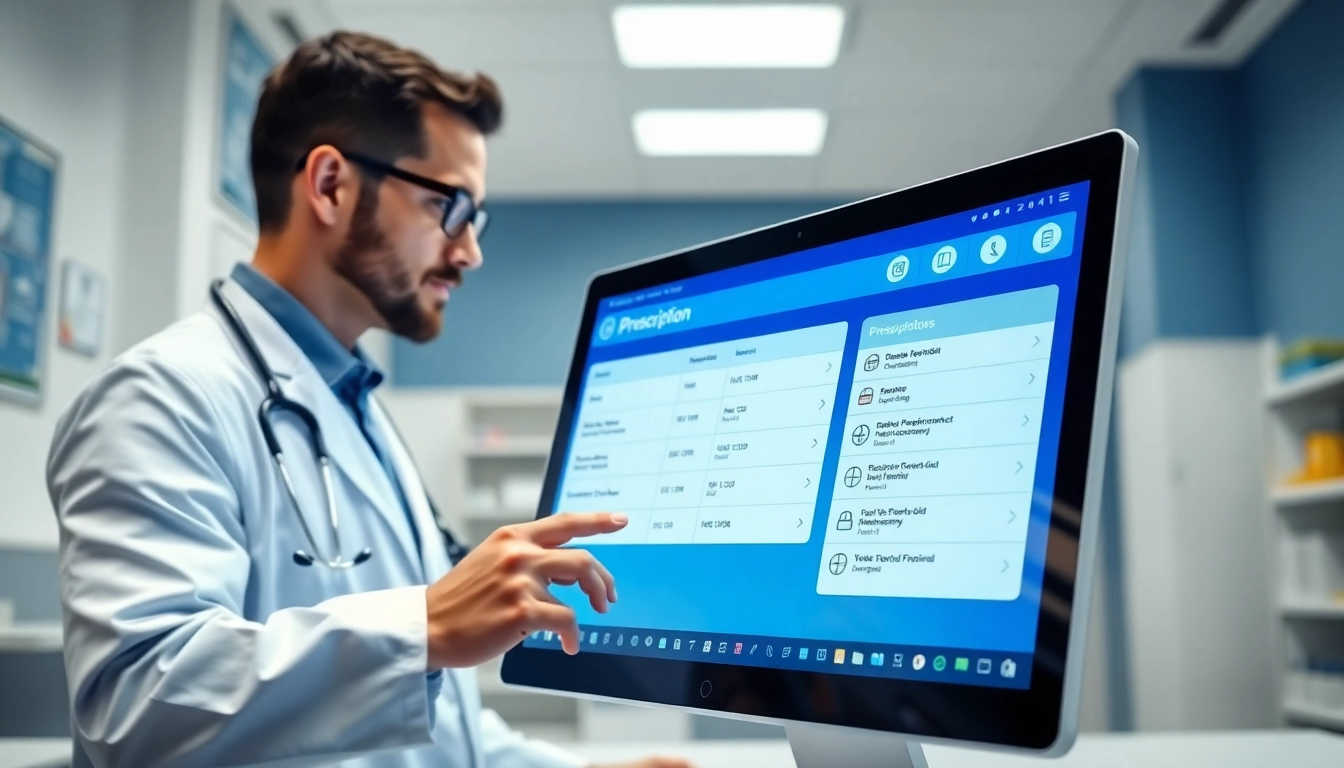Introduction to Eprescription Apps for Android
Eprescription apps are transforming the way healthcare providers manage prescriptions, streamline workflows, and enhance patient care. These digital solutions provide a much-needed alternative to traditional paper prescriptions, allowing healthcare professionals to send prescription information directly to pharmacies with ease. This article explores the myriad benefits of using eprescription apps for android, the key features they offer, popular apps on the market, and best practices for implementation.
What Are Eprescription Apps?
Eprescription apps are mobile applications designed for healthcare professionals, enabling them to electronically create, send, and manage prescriptions for their patients. These platforms eliminate the need for handwritten prescriptions, reducing the risk of errors associated with poor handwriting or lost paper documents. By utilizing secure, cloud-based systems, healthcare providers can access patient information and medication records from anywhere, leading to improved prescribing accuracy and efficiency.
Benefits of Using Eprescription Apps
The transition to e-prescribing comes with numerous advantages:
- Increased Efficiency: Eprescription apps enable rapid transmission of prescriptions, saving time for both physicians and pharmacists.
- Enhanced Safety: By eliminating handwritten prescriptions, these apps reduce the chances of errors due to misinterpretation.
- Improved Patient Adherence: Built-in features, such as medication reminders, foster better patient adherence to prescribed regimens.
- Cost-effectiveness: Electronic prescriptions can significantly lower overhead costs related to paper processing and storage.
How Eprescription Apps Enhance Workflow
Eprescription apps significantly streamline various aspects of clinical workflows:
- Instant Prescription Updates: Any updates made to patient prescriptions are instantly reflected across their medical records, ensuring that everyone involved in patient care is informed.
- Access to Drug Interaction Information: Many apps come with databases that provide real-time information about potential drug interactions, allergies, and contraindications.
- Compliance with Regulations: Eprescription apps help clinicians meet local and national regulations regarding medication management and patient safety.
- Telemedicine Integration: With the rise of telehealth, e-prescriptions fit well into virtual consultation frameworks, allowing prescriptions to be dispatched quickly after a telemedical appointment.
Key Features of Eprescription Apps for Android
User-Friendly Interfaces
A significant advantage of e-prescription apps is their user-friendly interfaces, designed to facilitate quick navigation. Most apps offer intuitive layouts, allowing healthcare practitioners to enter patient data, select medications, and send prescriptions with minimal training.
Integration with Medical Records
Effective e-prescription apps seamlessly integrate with Electronic Health Records (EHR) systems. This integration ensures that providers have access to a patient’s comprehensive medical history, enabling informed decision-making when prescribing medications. The synchronization of data reduces the chances of prescribing errors and provides a holistic view of patient health.
Secure Prescription Transmission
Security is a paramount consideration in healthcare technology. Eprescription apps employ strong encryption protocols to safeguard patient information during transmission. Secure access ensures that only authorized personnel can view sensitive data, adhering to HIPAA regulations to protect patient privacy.
Popular Eprescription Apps for Android
Overview of Leading Options
When considering the best eprescription apps, it’s essential to evaluate those that are widely recognized for their functionality and user satisfaction:
- ScriptSure: Known for its comprehensive features, ScriptSure offers e-prescribing, refill requests, and seamless pharmacy integration.
- iPrescribe: This app stands out due to its strong focus on user experience and medication adherence, making it easy for prescribers to manage patient prescriptions.
- MDToolbox-Rx: MDToolbox provides a robust e-prescribing platform that includes customizable templates and drug interaction alerts.
- NextGen Office: This application offers a full suite of healthcare management features, including e-prescribing, billing, and patient scheduling.
- RXNT: A fully cloud-based solution, RXNT allows healthcare providers to e-prescribe efficiently, with features catered to small practices and large healthcare systems.
Comparative Analysis of Features
The following table summarizes the features of several popular e-prescription apps, allowing healthcare providers to compare their options effectively:
| App Name | User-Friendliness | Integration with EHR | Security Features | Cost |
|---|---|---|---|---|
| ScriptSure | High | Yes | HIPAA Compliant | Varies |
| iPrescribe | Very High | Yes | HIPAA Compliant | Free for basic use |
| MDToolbox-Rx | Moderate | Yes | Strong Encryption | Subscription Based |
| NextGen Office | High | Yes | HIPAA Compliant | Custom Pricing |
| RXNT | High | Yes | Strong Encryption | Subscription Based |
User Reviews and Ratings
User reviews often provide valuable insights into the effectiveness of e-prescription apps. Users consistently highlight features that improve their workflow and impact patient care:
- User Satisfaction: Most users report high satisfaction levels with the general usability and reliability of these apps.
- Support Services: Quick customer support response times are frequently noted as a significant benefit.
- Customizability: Many apps allow customization to fit the unique needs of different practices, a feature highly praised by users.
Choosing the Right Eprescription App
Assessing Practice Needs
When selecting an e-prescription app, healthcare providers should assess several factors regarding their practice needs:
- Practice Size: Determine whether the needs of a small practice differ from those of a larger healthcare facility.
- Specialty Requirements: Some specialties may require specific functionalities that are only available in certain apps.
- Compatibility: Ensure the app can integrate with existing EHR systems to facilitate smooth operations.
Cost Considerations
Cost is a significant factor in selecting an e-prescription app. Providers should consider:
- Initial Setup Costs: Understand any upfront costs associated with acquiring software and hardware.
- Ongoing Subscription Fees: Evaluate whether the ongoing costs fit within the practice’s budget.
- Potential Savings: Assess how the app may lead to cost savings over time through increased efficiency and reduced errors.
Trial Options and Demonstrations
Before committing to a particular e-prescription app, healthcare providers should take advantage of trial options and demonstrations:
- Free Trials: Many apps offer a free trial period, allowing providers to assess usability.
- Demo Sessions: Schedule demonstration sessions with vendors to see the app in action and ask questions about specific features.
Implementing Eprescription Apps Effectively
Training Staff on New Technology
The success of e-prescription apps largely depends on how well staff are trained:
- Comprehensive Training Programs: Develop training programs that cover all aspects of the app.
- Ongoing Support: Ensure that staff have access to ongoing support as they adapt to these new tools.
Monitoring Usage and Adoption Rates
Monitoring the adoption of e-prescription apps is critical for evaluating their integration:
- Utilization Metrics: Track how often the app is used to gauge its overall effectiveness.
- User Feedback: Regularly collect feedback from staff to identify areas for improvement.
Evaluating Impact on Patient Outcomes
Ultimately, the effectiveness of e-prescription apps should be measured by their impact on patient outcomes:
- Adherence Rates: Monitor medication adherence levels among patients prescribed medications via the app.
- Prescription Errors: Assess the reduction in prescription errors since implementing the app.
- Patient Satisfaction: Regularly survey patients about their experiences with prescribed medications and any perceived changes in their care.
Conclusion
The adoption of e-prescription apps for Android has the potential to dramatically simplify the prescription process for healthcare providers while enhancing patient care. By selecting the right app, ensuring proper training, and monitoring usage effectively, healthcare providers can achieve unprecedented efficiency and accuracy in their prescribing practices. As technology continues to evolve, e-prescribing will undoubtedly become an indispensable tool in modern healthcare.



